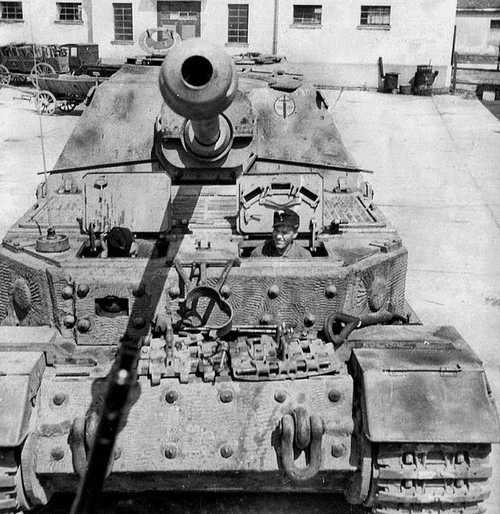
German Armored Forces & Vehicles
"Elefant" tank destroyer, Sch.PzJg.Abt 653.
?Bundesarchiv.
"Elefant" tank destroyer of Heavy Tank Destroyer Battalion 653 (Schwere Panzerjager Abteilung 653), probably Headquarters Company, ?Italy, Spring/Summer, 1944. The 653rd, along with Schwere Panzerjager 654, was attached to the northern front at Kursk ("Zitadelle") in 1943, equipped with the very similar earlier version of this vehicle, commonly known as the "Ferdinand". Results were somewhat mixed, overall. The "Ferdinand" was very heavy and underpowered. However, it packed the punch of a fully-fledged Tiger I tank with its 88mm gun, and its very heavy frontal armour rendered it effectively immune from pretty well any anti-tank gun deployed by the Soviets in 1943. When used appropriately - in effect, as a "breakthrough tank" or in defence - it could be highly effective. T-34/76 tanks had no response to the Ferdinand's frontal armour, and could be dispatched with ease. Overall kill rates at Kursk greatly favoured the Ferdinand; Schwere Panzer Abteilung 653, for example, claimed a kill rate of 10 to 1 in its favour in that battle. The "1", however, was a problem. In the secordary phase of the battle, when the Ferdinands were required to advance into the Soviet defensive zone, numerous vehicles were detracked by Soviet anti-tank fire and by mines. Actual losses were limited at this stage by the efforts of vehicle recovery crews. However, their work was inhibited by the weight of the Ferdinand, which required between 4 and 6 of the standard recovery vehicles available at the time to tow one. Another problem was that, in the extremely infantry-unfriendly environment for the Germans in this phase of the battle, Ferdinands that outran (or outcrawled) their infantry support could fall victim to the Soviet anti-tank squads infesting the battlefield, who might succeed in detracking the vehicle or destroy it with magnetic mines - or even with petrol bombs and hand grenades. The lack of a defensive machine-gun greatly magnified this problem; crews were reduced to emergency expedients such as firing their unmounted machine-gun down the barrel of the main gun, or using ad-hoc external machine-gun mountings that resulted in heavy casualties among the crewmen or infantrymen required to use them. Sometimes, crews were reduced to firing high-explosive rounds at attacking infantry - resulting in Manteuffel's comment about attempting to shoot quail with a cannon. Finally, the "Ferdinand", with its centrally-mounted engine and complex fuel system, proved vulnerable to well-directed flank hits from Soviet 76.2 tank guns, which could set the vehicle on fire even if the hit did not penetrate. The problems revealed at Kursk resulted in the withdrawal of the Ferdinand, and the production of a modified version, the "Elefant". Most Ferdinands suitable were converted to this new pattern. The main improvements were the provision of even heavier armour, the addition of a glacis-mounted machine-gun, and of a commander's copula adapted from the PzKpfw IV that improved the very limited external visibility of the vehicle. Most of the new/modified vehicles, including Schwere Panzerjager Abteilung 653, were transferred to Italy, where the limitations of terrain, in a peculiar way, facilitated the appropriate use of their "Jagerpanzers". The "Ferdinand/Elephant" was ultimately withdrawn in favour of the new, Tiger II - based Jagdtiger, but only on a very limited basis. Only two Heavy Tank Destroyer Battalions were issued with the new vehicle - Schwere Panzerjager Battalions 653 and 654. These fought with Jagdtigers in the final phases of the western campaign. Schwere Panzerjager Abteilung 654 was where Tiger ace Otto Carius completed his career - much to his irritation, in view of his dislike of the Jagdtiger. Best regards, JR.
5305 Views
2/24/2015
